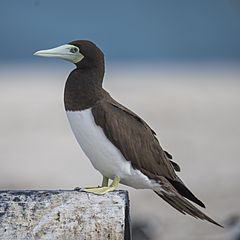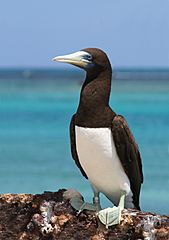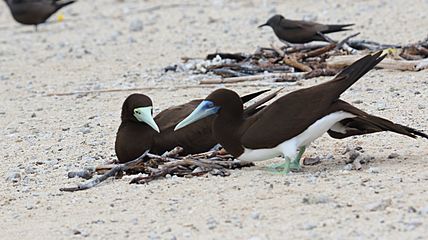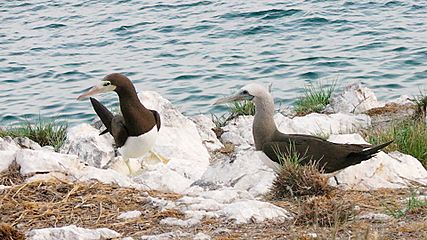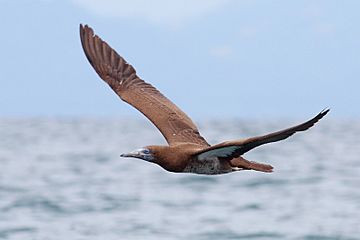Brown booby facts for kids
Quick facts for kids Brown boobyTemporal range: Middle Quaternary to recent
|
|
|---|---|
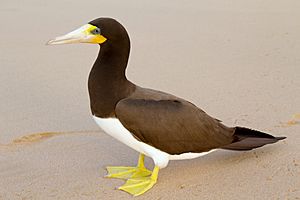 |
|
 |
|
| Adult male (nom.) with blue orbital ring, and an adult male (S. l. plotus) in flight | |
| Conservation status | |
| Scientific classification | |
| Genus: |
Sula
|
| Species: |
leucogaster
|
 |
|
| World range, with subspecies: S. l. plotus nominate S. l. etesiaca S. l. brewsteri | |
The brown booby (Sula leucogaster) is a large seabird. It belongs to the booby family, called Sulidae. This bird is probably the most common and widespread booby species.
Brown boobies live all over the tropical parts of the world. They often share their homes with other booby species. These birds like to be in groups. They fly and hunt close to the water in coastal areas. Brown boobies dive headfirst into the ocean to catch small fish. They especially like fish that are pushed to the surface by bigger predators. These birds only build their nests on the ground. They also rest on solid objects, not on the water.
Contents
About the Brown Booby's Name
The brown booby was first described in 1781 by a French scientist named Georges-Louis Leclerc, Comte de Buffon. Later, in 1783, a Dutch scientist named Pieter Boddaert gave it its scientific name, Pelecanus leucogaster.
The current group name, or genus, for the brown booby is Sula. A French zoologist named Mathurin Jacques Brisson introduced this name in 1760. The word Sula is a Norwegian word for a gannet, which is another type of seabird. The second part of its scientific name, leucogaster, comes from Ancient Greek. Leuko means "white" and gastēr means "belly". This name describes the bird's white belly.
Different Kinds of Brown Boobies
There are four main types, or subspecies, of brown boobies around the world:
- S. l. leucogaster (Boddaert, 1783) – Found in the Caribbean and islands in the Atlantic Ocean.
- S. l. brewsteri Nathaniel Stickney Goss, 1888 – Lives along the Pacific coasts of the USA and Mexico.
- S. l. etesiaca Thayer & Bangs, 1905 – Found along the Pacific coasts of Central America and Colombia.
- S. l. plotus (Forster, JR, 1844) – Lives from the Red Sea, across the Indian Ocean, to the western and central Pacific Ocean.
What Brown Boobies Look Like
The brown booby has a dark brown to black head and upper body. Its belly is a bright white, which stands out. The colors of their bare skin, like around their eyes, can be different depending on where they live. These colors do not change with the seasons.
Male and female brown boobies also have slightly different colors around their eyes. Males have a blue ring around their eyes. Females have a yellow ring. Also, the male of the S. l. brewsteri subspecies looks a bit different. Its forehead, top of the head, and chin are white. This color blends into a grayish-brown neck and chest.
Size and Weight
Female brown boobies are usually larger than males.
- A female can be about 80 centimetres (31 in) (31 inches) long.
- Her wingspan can reach up to 150 cm (4.9 ft) (5 feet).
- She can weigh up to 1,300 g (2.9 lb) (2.9 pounds).
Male brown boobies are a bit smaller:
- A male can be about 75 centimetres (30 in) (30 inches) long.
- His wingspan can reach up to 140 cm (4.6 ft) (4.6 feet).
- He can weigh up to 1,000 g (2.2 lb) (2.2 pounds).
Young Brown Boobies
Unlike some other seabirds, young brown boobies look a lot like the adults. They are gray-brown. Their head, the top of their wings, and tail are darker. Their lower chest and belly feathers are mostly white with many brown spots. Young boobies of the S. l. brewsteri subspecies are different. Their belly feathers are a more even mouse-brown color.
Beaks, Wings, and Sounds
Brown boobies have very sharp beaks with jagged edges. Their wings are quite short, so they flap them quickly when flying. They also have long, pointed tails.
These birds are usually quiet. However, people who watch birds have heard them make sounds. These sounds are sometimes like grunting or quacking.
How Brown Boobies Live
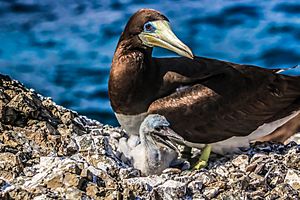
Brown boobies live and have their babies on islands and coasts. They are found in tropical areas of the Atlantic and Pacific oceans. They often use islands in the Gulf of Mexico and the Caribbean Sea for breeding.
Sadly, brown boobies have started using marine debris to build their nests. This means they use trash from the ocean. More than 90% of their nests have been found to contain plastic. Nests near shipwrecks might even have pieces of the wreckage.
Nesting and Chicks
These birds build their nests in large groups, called colonies. They lay two chalky blue eggs on the ground. The nest is a small mound made of broken shells and plants. However, they usually only raise one chick. The second chick to hatch often cannot get enough food. Sometimes, the older chick even pushes the younger one out of the nest. When winter comes, brown boobies fly out to sea over a larger area.
Brown booby pairs often stay together for many years. They have special ways of greeting each other. They are also amazing divers. They plunge into the ocean at very high speeds to catch food.
Hunting and Flying
Brown boobies mainly eat small fish or squid. They look for groups of these animals near the water's surface. They can even catch fish that jump out of the water while they skim the surface.
Even though they are strong and good at flying, they can be a bit clumsy when taking off and landing. They often use strong winds and high places to help them get into the air.
Gallery
-
Female at Green Island, Queensland
-
Male at French Frigate Shoals, Hawaii
-
S. l. brewsteri pair, Islas Marietas N.P., Mexico
-
Juv. in flight, Gulfo Dulce, Costa Rica
Images for kids
-
Juvenile, São Tomé and Príncipe
-
Older juvenile, São Tomé and Príncipe
See also
 In Spanish: Piquero pardo para niños
In Spanish: Piquero pardo para niños



